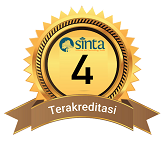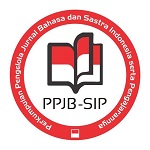MODEL PEMBELAJARAN BAHASA BERBASIS TUGAS (PBBT) MELALUI PEMBELAJARAN DARING
Abstract
PBBT is a language learning method that focuses on learners. In practice, PBBT is a language learning system that is focused on the task. Assignments given to learners are central to language teaching activities. In general the assignment of students can be said as a basic concept of PBBT. However, in this case the assignment of students at the beginning of learning becomes the hallmark of this method. With this method the teacher's role as a mediator, facilitator, and supervisor is more optimal. PBBT enables students to produce target languages through communicative task completion. The way PBBT works contains the following principles: (1) assignments must be designed to foster student motivation; (2) tasks must be accessed with information technology or the internet; and (3) assignments can foster student independence, tenacity, and honesty. In addition, the current learning process is not just a transfer of knowledge from teachers to learners, but has shifted through electronic media, be it computers, devices, and cellular phones that can be accessed anytime and anywhere according to the wishes of the learner. That as an effort to the presence of information technology and the internet must be utilized as well as possible to develop learning.
Full Text:
Full Paper (Bahasa Indonesia)References
Boston, J. 2010. Pre-Task Syntactic Priming and Focused Task Design. ELT Journal, 64: 165–174.
Ellis, Rod. 2000. Task-Based Research and Language Pedagogy. Language Teaching Research vol. 4 (3), pp. 193 – 220.
Jeon, In-Jae and Hahn, Jung-won. 2006. Exploring EFL Teachers' Perceptions of Task-Based Language Teaching: A Case Study of Korean Secondary School Classroom Practice. Mokpo: Mokpo National University, Korea.
Nunan, David. 2004. Task-Based Language Teaching. Cambridge: Cambridge University Press.
Prabhu, N. 1987. Second Language Pedagogy. Oxford: Oxford University Press.
Richards, Jack.C. and Rodgers, Theodore S. 2001. Approaches and Methods in Language Teaching. (2nd ed). Cambridge: Cambridge University Press. Sánchez, Aquilino. 2004. The TaskBased
Robinson, P. (2011). Task-based learning: A review of Issue. Language Learning. Tokyo: A Journal of research in language studies, 61(sl), 1- 36.
Salwa, Athiyah. (2019). Model Task-Based Learning untuk Membangun Pembelajaran Mandiri Pada Tutorial Online. Jurnal Pendidikan Terbuka dan Jarak Jauh, Volume 20, Nomor 1, Maret 2019, 10-16.
Thomas, Michael and Reinders, Hayo.2011. Task-Based Language Learning and Teaching with Technology. Language Learning and Technology, October 2011, Volume 15, Number 3 pp. 3236.
Willis, J. 1996. A Framework For Task-Based Learning. Edinburgh: Addison Wesley.
Zakime, Andreia. (2018). What is Task Based Learning?. Available at:https://www.whatiselt. com, acssesed 29 Mei 2018.
DOI: https://doi.org/10.21107/metalingua.v5i2.8886
Refbacks
- There are currently no refbacks.
Copyright (c) 2020 Sulaiman Sulaiman Sulaiman

This work is licensed under a Creative Commons Attribution-ShareAlike 4.0 International License.
Jurnal Pendidikan Bahasa dan Sastra Indonesia Metalingua by Universitas Trunojoyo Madura is licensed under a Creative Commons Attribution-ShareAlike 4.0 International License.















